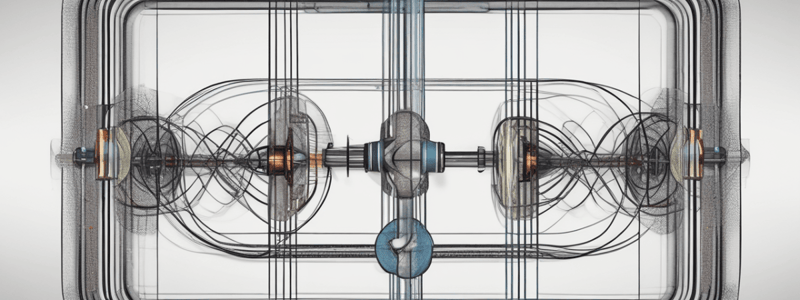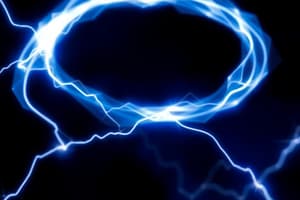Podcast
Questions and Answers
What is the unit of electric charge in the SI system?
What is the unit of electric charge in the SI system?
- Coulomb (correct)
- Volt
- Newton
- Ampere
Which of the following correctly describes the relationship stated in Coulomb's Law?
Which of the following correctly describes the relationship stated in Coulomb's Law?
- The force is inversely proportional to the square of the distance between charges. (correct)
- The force is directly proportional to the sum of the charges.
- The force is independent of the magnitude of the charges.
- The force is directly proportional to the distance between charges.
How does the charge type affect the direction of the electrostatic force?
How does the charge type affect the direction of the electrostatic force?
- Unlike charges repel each other.
- Like charges attract each other.
- Like charges repel each other. (correct)
- The charge type has no effect on force direction.
What happens to the Coulomb force as the distance between two charges approaches infinity?
What happens to the Coulomb force as the distance between two charges approaches infinity?
Which principle is employed to determine the net force on a charge due to multiple other charges?
Which principle is employed to determine the net force on a charge due to multiple other charges?
What happens to the net Coulomb force when charges overlap, leading to $r=0$?
What happens to the net Coulomb force when charges overlap, leading to $r=0$?
If two charges $q_1$ and $q_2$ are separated by a distance $r$, and the charges are both doubled while the distance is tripled, how does the force change?
If two charges $q_1$ and $q_2$ are separated by a distance $r$, and the charges are both doubled while the distance is tripled, how does the force change?
In maximizing the Coulomb force between two charges, what condition must be satisfied with respect to the ratio $q/Q$?
In maximizing the Coulomb force between two charges, what condition must be satisfied with respect to the ratio $q/Q$?
How does the electrostatic force between two electrons compare to the gravitational force acting on them?
How does the electrostatic force between two electrons compare to the gravitational force acting on them?
What is a consequence of applying Coulomb's law if two charges are overlapping?
What is a consequence of applying Coulomb's law if two charges are overlapping?
What is the nature of electrostatic forces between two charged objects?
What is the nature of electrostatic forces between two charged objects?
What happens when two electrically neutral objects are rubbed together?
What happens when two electrically neutral objects are rubbed together?
Which example best illustrates the effect of electrostatic forces?
Which example best illustrates the effect of electrostatic forces?
According to Benjamin Franklin's terminology, what are the two types of electric charges?
According to Benjamin Franklin's terminology, what are the two types of electric charges?
What is referred to as 'excess charge' in electrostatics?
What is referred to as 'excess charge' in electrostatics?
What happens to the electrostatic force when the magnitude of both charges is doubled while keeping the distance constant?
What happens to the electrostatic force when the magnitude of both charges is doubled while keeping the distance constant?
Under what condition can Coulomb's Law be applied correctly between two charges?
Under what condition can Coulomb's Law be applied correctly between two charges?
What is the nature of the force between two unlike charges, such as an electron and a proton?
What is the nature of the force between two unlike charges, such as an electron and a proton?
If the distance between two charges is halved, how does the electrostatic force change?
If the distance between two charges is halved, how does the electrostatic force change?
Which statement accurately compares electrostatic forces to gravitational forces?
Which statement accurately compares electrostatic forces to gravitational forces?
Flashcards are hidden until you start studying
Study Notes
Electrostatic Forces and Everyday Examples
- Electrostatic forces govern interactions between charged particles like electrons and protons.
- Common manifestations include hair standing on end when combed, balloons attracting paper, and glass rods repelling each other when rubbed with wool.
- Electrostatic interactions are "non-contact" forces, effective even at a distance.
Types of Electric Charges
- Electric charges can be positive or negative, a distinction made by Benjamin Franklin.
- Most objects are electrically neutral, having equal positive and negative charges.
- Rubbing materials can transfer charges, making them either negatively or positively charged.
- The law of charges states that like charges repel, while unlike charges attract.
Measuring Electric Charge
- Electric charge is quantified in Coulombs (C) in the SI system, where 1 C = 1 ampere flow for 1 second.
- In CGS, charge is measured in statcoulombs (statC).
Coulomb's Law
- Describes the electrostatic force (F) between two point charges (q1 and q2) as:
[ F = k \frac{{|q_1 \cdot q_2|}}{{r^2}} ] where r is the distance between charges and k is Coulomb's constant. - Coulomb's law is an inverse-square law, meaning force decreases with the square of distance.
- The direction of force is determined by the charge types: like charges repel; unlike charges attract.
Vector Form of Coulomb's Law
- For two charges separated by distance r, forces act along lines away from or towards the charges depending on charge types.
- The net force on a charge can be determined as a vector sum in systems with multiple charges.
Factors Affecting Coulomb Force
- Magnitude of Charges: Doubling charge magnitudes quadruples the force.
- Distance: Halving the distance between charges increases the force by a factor of four.
Conditions for Applying Coulomb's Law
- Charges must be stationary; moving charges generate currents, changing the interaction dynamics.
- Charges should be treated as point particles; complex calculations arise when dealing with extended objects.
- Charges must be non-overlapping; overlapping leads to infinite forces which are not physically meaningful.
Gauss' Law and Uniform Charge Distribution
- Gauss' Law relates electric flux through a closed surface to the total charge within the surface.
- For a uniformly charged sphere, treat the charge as a point charge located at the center.
Comparison: Electrical vs. Gravitational Forces
- Both Coulomb's force and gravitational force are inverse-square laws; however, electrostatic forces can be attractive or repulsive, whereas gravitational forces are solely attractive.
- Electrostatic force is significantly stronger than gravitational force at the subatomic level due to the nature of electric charge compared to mass.
Example Calculations Using Coulomb's Law
- Example 1: Force between an electron and proton attraction with equal magnitudes.
- Example 2: Net force calculation on a charge in a configuration with three charges.
- Example 3: Maximizing Coulomb force by optimizing charge transfer ratio.
Knowledge Check Questions
- Understand why charges must be non-overlapping for Coulomb's law to be valid; overlapping implies infinite forces.
- Calculate how force changes with modified charge magnitudes and distances for two equal charges.
- Assess the comparison between electrostatic and gravitational force magnitudes for electrons, highlighting the dominance of electrostatic interactions.
Studying That Suits You
Use AI to generate personalized quizzes and flashcards to suit your learning preferences.




